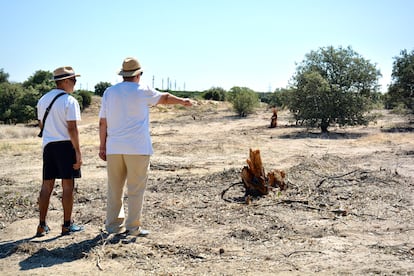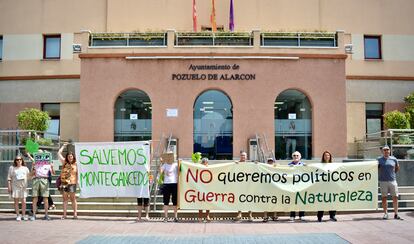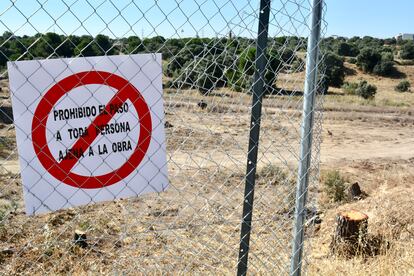In Spain’s wealthiest town, residents protest against luxury development that will cut down thousands of trees
The Montegancedo project plans to erect 1,050 homes in Pozuelo de Alarcón. Protesters say nearly 300 trees have already been felled in a natural space home to diverse animal and plant species


The harmonious silence that once enveloped La Cabaña, a natural space located within the city limits of Pozuelo de Alarcón, just outside Madrid, has been cut short by the sound of heavy machinery and the roar of chainsaws. This area has been slated to become a luxury development: the Montegancedo project will transform 70 hectares of forest into 1,050 homes, bringing nearly 4,000 new residents to an area of town where fewer than 2,000 live today. The plans initially involve cutting down a thousand trees just to create the roads of this new neighborhood. Nearly 300 have already been felled since early June, including centenary holm oaks with trunks up to 40 centimeters in diameter. The damage “is irreversible,” says a neighborhood association called Salvemos Montegancedo (Let’s Save Montegancedo).
On Thursday, several members of this group were kicked out of the city council, where they had gone to protest the project while a plenary session was underway. Pozuelo, which consistently ranks as one of the wealthiest municipalities in Spain — one of its most famous residents was former Real Madrid player Cristiano Ronaldo — is governed by the conservative Popular Party (PP) with an absolute majority. A motion filed by the opposition Socialist Party (PSOE) has momentarily halted the construction work, but it is a transitory measure. The developers insist that theirs is a “sustainable” project, while city officials underscore that it has received all the necessary favorable reports.
Luis Segundo Arana Sastre, 66, is one of the spokesmen for Salvemos Montegancedo. The new development project threatens to destroy much more than the natural area where he usually goes for walks. “To me, it erases my childhood. I was born here and I have been in these hills with my father. It destroys all the memory of what Pozuelo means to me,” he says. Besides being a lifelong resident, Arana Sastre also happens to have a degree in architecture, and has taught in the field for 12 years; he was also the municipal architect for the same period of time. He warns of a much greater environmental impact than what’s already been done. After creating the roads, more trees will have to be cut down, perhaps as many as 5,000, to make space for the buildings.

Montegancedo is a natural oasis for local residents. Every day, they can be seen cycling, running or walking their dogs. Pensioners take their morning walks here, and on weekends, entire families come to breathe clean air. A study on the environmental value of this area by Daniel Fuentes, a doctor in environmental sciences, counted more than 100 animal species including mammals, reptiles, amphibians and birds, some of them of great importance such as the imperial eagle, the black vulture and the red kite, a bird of prey at risk of extinction. The study also notes the presence of “numerous specimens” of holm oaks and stone pines “over one hundred years old, and some close to two hundred years old” as well as rockrose, broom, poppies and wild rose bushes.
The residents of western Pozuelo fear not only the environmental impact, but also the significant increase in the number of residents. The area most affected by the project is La Cabaña, bordering the Montegancedo estate. This area of about 1,500 residents could see its population triple. Joaquín Plaza, a local resident and member of the protest group, underscores that “one of Pozuelo’s problems is mobility,” something that can only get worse with the new arrivals.

Located just 14 kilometers by road (8.6 miles) from the Spanish capital, Pozuelo is an attractive location for those who can afford it. Many neighbors who gave up a life in the metropolis in search of rural tranquility declare themselves distressed to see their plans slip through their fingers. One of them is Susana Bennike, a native of Denmark who now lives in Pozuelo. She is a lover of green spaces and gets around by bicycle. “We came to live here so that our children could live next to nature, climb trees and learn from the animals”, she said. ‘Do you know how much we paid to have these silent nights?” Probably a lot, considering that Pozuelo is the municipality with the highest average per capita income in Spain.
The real estate companies Aedas Homes and Pryconsa are behind the Montegancedo project. Aedas, which acquired its share of the land in 2017, owns 50%, on which it plans to build 529 homes. Pryconsa has about 20% of the land, which it will use to raise 204 apartments. The remaining 30% will be delivered free of charge to the city to build “about 300 homes that will be incorporated into the Municipal Housing Plan,” as specified in writing by local authorities, who underscored the private ownership of the land, even though it had never been fenced or used all these years except by local residents. EL PAÍS reached Aedas for comment, but was referred back to official statements by Pozuelo officials. It was not possible to reach anyone at Pryconsa.
Arana Sastre describes as “perverse marketing” the advertising strategy of the construction companies that promote this type of project as sustainable. “We don’t reflect on what it means to live in nature, which is a very contemporary snobbery. In the end you don’t realize that when you buy a house in nature, it means you have previously destroyed nature.”
Sign up for our weekly newsletter to get more English-language news coverage from EL PAÍS USA Edition
Tu suscripción se está usando en otro dispositivo
¿Quieres añadir otro usuario a tu suscripción?
Si continúas leyendo en este dispositivo, no se podrá leer en el otro.
FlechaTu suscripción se está usando en otro dispositivo y solo puedes acceder a EL PAÍS desde un dispositivo a la vez.
Si quieres compartir tu cuenta, cambia tu suscripción a la modalidad Premium, así podrás añadir otro usuario. Cada uno accederá con su propia cuenta de email, lo que os permitirá personalizar vuestra experiencia en EL PAÍS.
¿Tienes una suscripción de empresa? Accede aquí para contratar más cuentas.
En el caso de no saber quién está usando tu cuenta, te recomendamos cambiar tu contraseña aquí.
Si decides continuar compartiendo tu cuenta, este mensaje se mostrará en tu dispositivo y en el de la otra persona que está usando tu cuenta de forma indefinida, afectando a tu experiencia de lectura. Puedes consultar aquí los términos y condiciones de la suscripción digital.
More information
Archived In
Últimas noticias
Most viewed
- Reinhard Genzel, Nobel laureate in physics: ‘One-minute videos will never give you the truth’
- Oona Chaplin: ‘I told James Cameron that I was living in a treehouse and starting a permaculture project with a friend’
- Pablo Escobar’s hippos: A serious environmental problem, 40 years on
- Charles Dubouloz, mountaineering star, retires at 36 with a farewell tour inspired by Walter Bonatti
- Why we lost the habit of sleeping in two segments and how that changed our sense of time










































